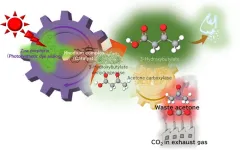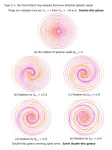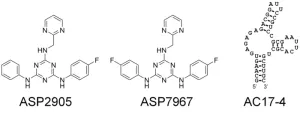Validation of a therapy that overcomes chemotherapy resistance in colon and rectal cancer
Adding a peptide, a molecule made up of several amino acids, to oxaliplatin, a chemotherapy drug used to treat colon and rectal cancer, avoids the side effects this treatment can have on normal tumour cells, including potential chemotherapy resistance
2023-03-30
(Press-News.org)
A multidisciplinary team made up of doctors and scientists from the Hospital del Mar Medical Research Institute (IMIM-Hospital del Mar) and the Institute for Research in Biomedicine (IRB Barcelona) has led a study, recently published in the Journal of Medicinal Chemistry, which proposes a therapeutic approach for preventing the development of resistance to chemotherapy with oxaliplatin, one of the standard treatments for colon and rectal cancer. The work, which also involved doctors from the Pathological Anatomy and Medical Oncology departments at Hospital del Mar, as well as researchers from the University of Oviedo and the CIBER on Cancer (CIBERONC), is a further step towards personalising the therapeutic approach to cancer.
In a study published in Nature Communications, this group of researchers had already shown how this type of chemotherapy accumulates in the healthy cells surrounding the tumour, the fibroblasts. This causes the activation of a number of genes linked to poor treatment response and tumour progression, which stimulates the tumour environment and helps tumour cells that have survived chemotherapy to proliferate once again. To prevent this, the authors of the new study propose adding a cell-penetrating peptide to oxaliplatin.
"Converting a systemic treatment, which affects healthy organs and the tumour microenvironment, by adding this peptide, allows us to transform it into something more specific, a targeted therapy, taking us closer to personalised medicine", points out Dr. Alexandre Calon, a researcher at the IMIM-Hospital del Mar and co-leader of the study. The conclusions are based on the analysis of tumour samples from nearly 200 colon and rectal cancer patients. In addition, ex vivo samples of tumours from mice and patients were analysed to show that adding a specific peptide to oxaliplatin reduced the adverse effects of this chemotherapy drug on normal tumour cells and could therefore reduce resistance to this treatment.
The results indicate that platinum accumulation in the tumour microenvironment in mice treated with this new approach drops dramatically and is up to 3.5 times lower. "We have seen that the chemotherapy load is reduced in fibroblasts treated with the new compound compared to those treated with oxaliplatin. This reduces the possibility of inducing tumour cell treatment resistance", explains Dr. Calon. It is therefore important to bear in mind that "Cancer does not just involve tumour cells, but there is also a microenvironment made up of blood vessels, fibroblasts and immune system cells, which are there to structure the tumour".
The researchers also determined that the new drug not only accumulates less around the tumour in mice, but also in the organs that are normally most heavily affected by chemotherapy, such as the colon itself, the kidneys and the liver. In this sense, as Dr. Jenniffer Linares, a researcher in the same group and first author of the study, explains "The classic treatment has a series of side effects on the patient, which we think could be reduced with the new drug, as less platinum accumulates in healthy tissues."
"This study is a crucial first step for the future clinical development of treatments that cause fewer side effects and are more effective in patients with colon and rectal cancer, taking into consideration the fact that the normal cells involved in tumours play a key role in treatment efficacy", explains Dr. Clara Montagut, head of the gastrointestinal tumour unit at the Hospital del Mar and a CIBERONC researcher.
These findings prompted Dr. Daniele Lo Re, who co-led the study, to observe that "By chemically modifying the structure of oxaliplatin, we can modulate its activity in the tumour microenvironment without any loss of efficacy. From this point on, we can think about integrating this approach into drug discovery processes, using appropriate cellular models that allow us to validate a greater number of potential new drugs both in the tumour and in its microenvironment."
The work was supported by the Carlos III Health Institute and the Spanish Association Against Cancer (Asociación Contra el Càncer).
Reference article
Peptide–Platinum(IV) Conjugation Minimizes the Negative Impact of Current Anticancer Chemotherapy on Nonmalignant Cells. Jenniffer Linares, Monica Varese, Anna Sallent-Aragay, Ana Méndez, Sergio Palomo-Ponce, Mar Iglesias, Eduard Batlle, Jorge Pisonero, Clara Montagut, Ernest Giralt, Daniele Lo Re, and Alexandre Calon. Journal of Medicinal Chemistry Article ASAP DOI: 10.1021/acs.jmedchem.2c01717
Other related articles
Linares, J., Sallent-Aragay, A., Badia-Ramentol, J. et al. Long-term platinum-based drug accumulation in cancer-associated fibroblasts promotes colorectal cancer progression and resistance to therapy. Nat Commun 14, 746 (2023). https://doi.org/10.1038/s41467-023-36334-1
END
ELSE PRESS RELEASES FROM THIS DATE:
2023-03-30
Plans to reintroduce the lynx in Scotland provoke a complex range of opinions, new research shows.
Lynx died out in Britain more than 1,000 years ago, but some conservation groups argue the species could help restore natural ecosystems.
The new study, by researchers from Vincent Wildlife Trust and the University of Exeter, investigated the views of stakeholders including farmers, land managers and conservationists.
“Our results show that views in Scotland about potential future lynx reintroduction are far more diverse, nuanced and complex than might have been assumed,” ...
2023-03-30
Poly-3-hydroxybutyrate—a biodegradable plastic—is a strong water-resistant polyester often used in packaging materials, made from 3-hydroxybutyrate as a precursor. In previous studies, a research team led by Professor Yutaka Amao from the Research Center for Artificial Photosynthesis at Osaka Metropolitan University, found that 3-hydroxybutyrate can be synthesized from CO2 and acetone with high efficiency, but only demonstrated this at higher concentrations of CO2 or sodium bicarbonate.
This new study aimed to reuse waste acetone from permanent marker ink and low concentrations of CO2—equivalent to exhaust gas from power plants, chemical ...
2023-03-30
A novel drug is showing promise for alleviating heart failure, a common condition associated with sleep apnoea and a reduced lifespan.
The drug, known as AF-130, was tested in an animal model at Waipapa Taumata Rau, the University of Auckland where researchers found it improved the heart’s ability to pump, but, equally important, prevented sleep apnoea, which itself reduces lifespan (see Nature Communications). “This drug does offer benefit for heart failure, but it’s two for the price of one, in that it’s also relieving the apnoea for which ...
2023-03-30
Even for insects, wood is a tough food source as it contains hard substances such as cellulose. To help make wood more palatable, some wood-feeding insects are assisted by symbiotic microorganisms that break down the components of wood into an edible form. A group from Nagoya University in Japan has isolated a symbiotic yeast from adults, larvae, and eggs of the Japanese longicorn beetle and identified specialized organs that store the yeast, allowing the beetles to break down the unpalatable components of wood. Their findings were published in PLOS ONE.
“I have been fascinated with longicorn beetles ...
2023-03-30
Urban honeybees could be used to gain insight into the microbiome of the cities in which they forage, which can potentially provide information on both hive and human health, reports a study published in Environmental Microbiome.
Cities are built for human habitation but are also spaces that host a wide range of living species, and understanding this diverse landscape is important for urban planning and human health. However, sampling the microbial landscape in a manner to cover wide areas of a city can be labour-intensive.
Elizabeth ...
2023-03-30
The standard cosmology can answer almost nothing about how the structure of a galaxy is formed. It expects a supermassive black hole at the center and dark matter in the halo to explain the circulation of stars and its velocity. However, why the visible matters are distributed in such a thin plane by the interaction with the black hole while dark matter results in a spherical distribution is a critical open question for a disc galaxy. The formation process of elliptical, ring, and long–barred galaxies also remains unknown.
The Energy Circulation ...
2023-03-30
A collaboration of Australian and European physicists predict that layered electronic 2D semiconductors can host a curious quantum phase of matter called the supersolid.
The supersolid is a very counterintuitive phase indeed. It is made up of particles that simultaneously form a rigid crystal and yet at the same time flow without friction since all the particles belong to the same single quantum state.
A solid becomes ‘super’ when its quantum properties match the well-known quantum properties of superconductors. A supersolid simultaneously has two orders, solid and super:
solid because of the spatially repeating pattern ...
2023-03-30
Throughout her career, Arizona State University Edson College of Nursing and Health Innovation Associate Professor Kelly Davis has worked to translate her research into action. An expert in alcohol-involved sexual assault, Davis’ studies have been cited in U.S. legislation and have earned her a MERIT Award and now the prestigious Fulbright Scholar Award.
The program will take her to the United Kingdom beginning in early 2024 to collaborate with colleagues at the University ...
2023-03-30
The Okinawa Institute of Science and Technology (OIST), in collaboration with Astellas Pharma Inc., has developed a new toolkit that uses small molecules to control the activity of a piece of synthetic RNA, and ultimately regulate gene expression. The technology, which was described in the Journal of the American Chemical Society on March 30, 2023, worked in mammalian cell cultures and in mice.
The ability to precisely control whether a gene is turned on or off is expected to lead to more efficient production of compounds that are made using animal cells, and make gene therapy, cell therapy, and regenerative medicine safer.
For genes to be expressed, cells make many RNA copies of a section ...
2023-03-30
It has been a longstanding assumption that birth mode and associated exposure of newborns to their mothers’ vaginal microbiome during delivery greatly affects the development of babies’ gut microbiome.
To test the scientific validity of this assumption, a team of Canadian researchers has now published a study in Frontiers in Cellular and Infection Microbiology in which they examined the effect of maternal vaginal microbiome composition on the development of infants’ stool microbiome at 10 days and three months after birth.
“We show that ...
LAST 30 PRESS RELEASES:
[Press-News.org] Validation of a therapy that overcomes chemotherapy resistance in colon and rectal cancer
Adding a peptide, a molecule made up of several amino acids, to oxaliplatin, a chemotherapy drug used to treat colon and rectal cancer, avoids the side effects this treatment can have on normal tumour cells, including potential chemotherapy resistance






